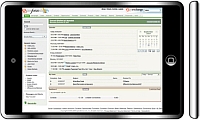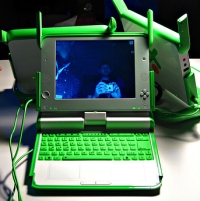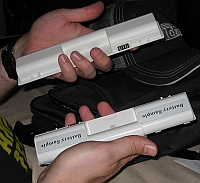This entry was first published on IT Redux. It's posted here with Ismael Ghalimi's permission.
I am Ismael Ghalimi and I am leading the effort to create Redux Model 1, an experimental device built for the Office 2.0 Conference.
When I first suggested the idea for the Redux Model 1, several people recommended that I start from an existing platform, instead of building the device from scratch.
Among the suggested candidates, the OLPC XO came highly praised, especially from my friend Darius Clarke. Unfortunately, it was not distributed to the general public, therefore could not be used as sacrificial starting point.
With the recent announcement of the Give 1 Get 1 program whereby you can buy two XO laptops for $399 and have one donated to a child, this situation has changed, and we are seriously considering using Negroponte's marvelous little machine for our Mini Tablet.
Unlike the Neo 1973 that we are also considering as a viable platform for our project, the OLPC XO has been designed has a scaled down laptop, not a beefed up phone. Nevertheless, so much attention has been given to power management that it would certainly match our requirements. The display is especially interesting. It uses a technology developed exclusively for the OLPC XO that allows it to be used either in reflective monochrome mode or transmissive color mode.
Using the former, power consumption drops from 0.2-1.0 Watt to a meager 0.1 Watt, and resolution goes up from 800 x 600 to 1200 x 900, which translates into a 200 dpi pixel density on this 7" display, higher than the first laser printer I used. Another interesting innovation is the ability to leave the display on while the CPU is off, reducing power consumption even more.
Using the OLPC XO as foundation would bring the following benefits over the Neo 1973:
- Ultra low cost ($200 with large LCD display vs. $300 without)
- High resolution display (1200 x 900)
- Reflective display option (very low power consumption)
- Mesh networking capabilities
- 1GB NAND flash
- Built-in camera (640 x 480 at 30 FPS)
- Support for 3G cellular networks
- Support for Adobe Flash
- Enhanced software stack
Assuming that we could source 2,500 units, some work would be required to turn the XO laptop into a Mini Tablet, without having to make any significant modifications to the XO's logic board. Here is a first list of things that would need to be figured out:
Touchscreen
First, we would need to turn the display into a touchscreen. This has been done by Axiotron for the ModBook, using a sacrificial MacBook and technology from WACOM, but it requires the use of a special pen, while we want a simpler finger-based interface, ideally supporting multi-touch gestures.
Two main technologies could be used: a resistive film or a capacitive glass panel. A resistive film is relatively cheap and very thin (1-3.5 mm), but offers only 75% to 85% clarity. A capacitive glass panel is more expansive and a lot thicker (3.5-4.5 mm), but offers close to perfect clarity. Technology for the touchscreen could be sourced from Touch International. This component should add less than $50 to the cost of the device.
Cellular Modem
Second, we need to add a cellular modem to the platform. We could either add a standard ExpressCard/34 slot into which users could slide their modem of choice, or use an embedded modem such as one of Novatel's Expedite Modules. This second option might be preferred, for it would allow us to reduce the device's dimensions and embed the modem's antenna into the tablet's case.
Novatel's modules are especially attractive because they all natively support the Linux operating system, and are available for both the North American (EU860D) and the European (EU870D) markets, supporting HSPDA, UMTS, GPRS, and EDGE networks. This component would add about $200 to the cost of the device.
Assisted GPS
Now that we've been dreaming about some cool location-aware applications, the GPS appears to be a must-have feature. For this purpose, a module based on SiRF's SiRFstarIII GSC3LT seems to be the way to go. It would provide excellent performance, very low power consumption (50 mW for continuous tracking at 1 Hz), power regulation, and multimode A-GPS. It is even WAAS capable, making it extremely useful for pilots. This component should add less than $50 to the cost of the device.
Battery
The OLPC XO can use either LiFePO4 or NIMH batteries. In order to increase battery life, the Redux Model 1 should use Li-ion batteries though. Based on publicly-available information, it is not clear whether the XO's power controller is located on the main logic board, or on a separate board connecting to the keyboard.
The later would make it easier for us to design a custom board that would include a power controller supporting multiple batteries used in parallel (the magnetic keyboard adds one or two), the cellular modem, and the GPS.
Encasing
Once again, the most challenging task in this project will be the development of an encasing for the device. One of the major drawbacks of using the OLPC XO as base platform is the fact that it's main logic board is very thick. While its outside dimensions should not make it a problem to fit within the half letter footprint we have selected (8.5" x 5.5"), keeping the tablet's thickness under half an inch should be close to impossible.
Based on publicly available information, the OLPC XO display module is less than 6.5" wide, leaving one inch on both sides to fit the cellular modem and GPS modules, but adding the battery, touchscreen and touchscreen controller will most likely drive the tablet's thickness to about 3/4".
All in all, the OLPC XO looks like a perfect candidate platform for our device. We could most likely use its logic board as is, and develop a Mini Tablet that would offer great performance and very long battery life. Benefiting from a large developer community building software for millions of users would also be a plus. At this point, the only thing that might prevent us to go down that path is the impossibility of sourcing 2,500 units, even if we were to offer as many off-the-shelf XO laptops to children.
Any help on this front would be much appreciated…
This entry was first published on IT Redux. It's posted here with Ismael Ghalimi's permission.





touch screen not just a great idea, imho touch screen is essential.. target deploy is kids, 6-12 yrs old.. not all of 'em are literate..
after playing w/ an xob4 for a few hours, my general impression was the interface wasn't stoopid simple easy, but maybe:
* the software might not have been there yet
* i'm old.. kids grok it quicker than me
* networking xo's more interesting than one lone xo
whatever.. point is, keyboards aren't the only way to communicate.. proof: adding camera to the xo added lots of value to it.. now people can communicate without dealing with a freaking keyboard.. so adding touch to the xo may also add great value..
personally, i'm starting to get some doubts about the grand xo scheme.. i'm thinking/hoping a few generations down the iphone/gphone/wtfone road will:
* improve both touch and voice interface
* mesh network connect us
* drive costs down
* cycle value up
* evolve business models to include everyone
even without grand initiatives and billion unit orders, cell phones are changing communications parameters in india, africa etc..
equal access to communication is happening now and from ground up.. as we all get more equal access to communication, we all get more equal access to wikipedia etc educational resources..
equal access to education is a revolution, but is it possible without equal access to communication?.. why not cut to the chase?
Thanks for posting this article.
I would like to get some help from the community.
I'm looking for the following information:
I need to know the following:
- outer dimensions (including height) of the main logic board
- function of the secondary logic board (power control? keyboard control?)
- outer dimensions of the LCD display with and without steel frame
Thanks in advance for your help.
-Ismael
Perhaps you should also look at other tablet options.
I've noticed the Windows CE powered DT375 http://www.dt375.com/ seems to have everything you would want in a portable wireless machine.
In the special education community and the community that supports people who use alternate ways to communicate, we have all been very interested in a touch screen solution. In many ways, if that drops, it would change the whole landscape for people who use computers to "talk". At this point the going rate is between 4 and 8 thousand dollars for a solution of this type. Seeing a $300 open source solution would truly be a miracle for so many. We'll see...
I like these ideas except the cellular modem, and the GPS. Why not just bluetooth connect to your phone that already has all that connectivity and GPS ability? Save some space, weight and $.
This will make a great eBook and general content consuming device.
I have gotten a quote for $200 for a touch screen add on. That one modification could make this a revolutionary augmentative communication device for those who do not speak.
I can't help but think children in 3rd world countries have disabilities too and some of them need augmentative communication. I'd like to see the assistive tech community embrace this project.
Here's a guy adding a touchscreen to an asus eee.
Hope it helps
http://youtube.com/results?search_query=asus+eee+touchscreen&search=Search